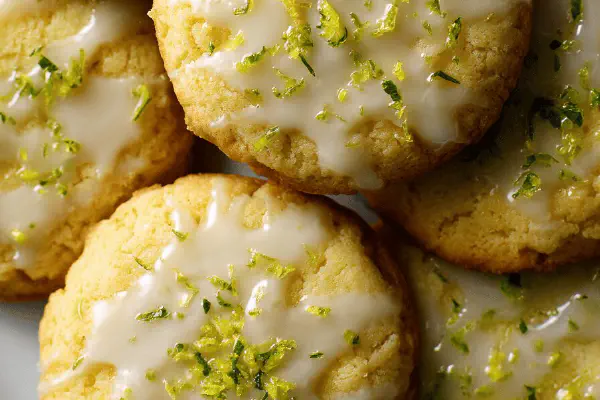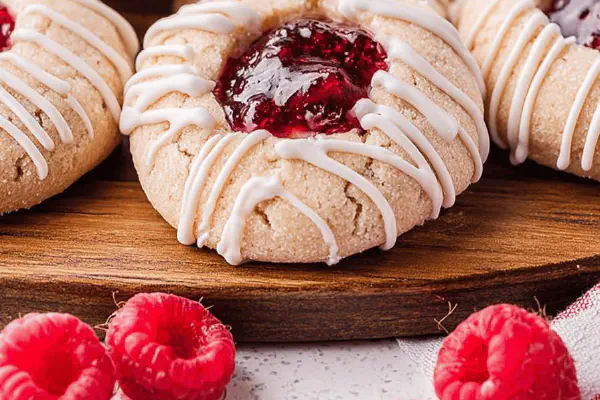Mirror-Glazed Cookies

By Emma
Certified Culinary Professional
Ingredients
- 150 ml unsalted butter softened
- 200 ml granulated sugar
- 1 large egg yolk
- Grated zest of 1 lime
- 400 ml all-purpose flour
- 7 ml baking powder
- 1 large pinch kosher salt
Glaze
- 900 ml powdered sugar
- Aquafaba from 2 chickpeas cans (approximately 3/4 cup)
- Water as needed
- Vanilla extract 5 ml
- Turmeric pinch for color
About the ingredients
Method
Dough Preparation
- 1. Cream the softened butter and sugar vigorously for around 3 minutes until pale and fluffy. The noise of the mixer changes pitch—listen for a slight airy whistle. Don’t rush; that fluff is the base for tender crispness.
- 2. Stir in egg yolk only—technically less moisture, firmer dough. Add lime zest for a sharper, fresher edge than lemon. Lime cuts sweeter notes, balances sugar. Beat 30 seconds more.
- 3. Sift together flour, baking powder, and salt. Never skip sifting—avoids clumps, ensures even rising. Mix dry into wet with a wooden spoon; avoid overworking. Just until no streaks. Too much and the texture goes tough.
- 4. Form a log about 6 cm diameter (smaller than usual). Tighter, easier to chill evenly. Wrap tightly in plastic. Refrigerate 2 1/2 hours, shorter due to smaller size but still firm to touch, cold but not rock solid.
Baking and Cutting
- 5. Heat oven to 175°C (347°F). Middle rack best. The slightly lower temp gives a gentler crust, baking slower interior, helping the glaze adhere.
- 6. The log should yield slight resistance when pressed. Slice into 0.4 cm thick rounds—thinner slices crack less, crisp quicker. Arrange on parchment, spaced. Wet knife prevents dragging—always dampen between cuts.
- 7. Bake 18-20 minutes. Watch edges for the slightest caramel tinge. The top stays pale, firmer edges tell enough. Remove, cool fully on wire rack before glazing or the sheen won’t hold.
Glazing
- 8. In a bowl, mix powdered sugar with aquafaba—the trick is to get a thick but spreadable consistency. Add vanilla to lift flavor, turmeric pinch for soft golden tone that mimics an egg yolk better than artificial dyes.
- 9. Reserve about 120 ml of this glaze and keep separate. Spread the rest evenly over tops; use an offset spatula to avoid pockmarks. Let glaze dry until firm but still sticky to touch, about 10 minutes depending on humidity.
- 10. Color reserved glaze darker with extra turmeric, test tint on scrap. Use a small spoon to dollop ‘yolk’ spots on each cookie’s center. Not perfectly round, slight wobble adds charm. The yellow spots should stay shiny, contrasting matte white glaze.
- 11. Let the glaze cure fully at room temp, minimum 30 minutes. Storing in fridge dulls glaze shine and breaks its texture. Best eaten same day or next for snap and gloss.
Tips and Troubleshooting
- If dough softens too fast, chill slice tray briefly before baking. In humid kitchens, adjust glaze with less water to prevent runny finish. Aquafaba can thin glaze—small increments with water, test by spreading, is safer than adding all at once. Substitute coconut oil for butter but expect less rise and buttery flavor. Don’t skip step of cooling before glazing or risk melting your shiny mirror.
- Common pitfall: slicing too thick—ends up doughy, glaze won’t crack but cookie feels heavy. Also, underbake slightly for chewy center if desired but glaze won't hold as long in moisture.
Cooking tips
Chef's notes
- 💡 Chill dough log smaller diameter than usual. 6 cm enables even firm chill fast but watch firmness no cracks. Egg yolk lowers moisture for tight dough. Slice thin 0.4 cm; thick slices trap moisture, cause doughy centers. Damp knife mandatory—wipe between cuts keeps edges clean no drag. Cooler tray in humid kitchens prevents dough softening before bake.
- 💡 Butter and sugar need to be creamed long—around 3 minutes. Look for pale, airy mix. Listen closely—mixer’s pitch shifts slight whistle, subtle but key. Aeration forms crumb baseline. Skip rushing here, no shortcuts. Overbeat risks heat melting butter, too little means dense dough. Texture shows in final crisp edges and light inside.
- 💡 Baking temp set slightly lower at 175°C. Slow crust formation keeps edges tender, not golden harsh. Watch edges closely for caramel tinge, not the top color. Top remains pale, edges firm tell readiness. Timing is 18-20 minutes but varies by oven humidity. Use aroma—sweet lemon scent intensifies as sugar caramelizes, signals close to done.
- 💡 Glaze requires thick consistency. Aquafaba mix first, then water dropwise for spreadable but not runny glaze. Test by spreading small patch. Thin glaze runs off cookies dulling shine. Vanilla lift flavor, turmeric pinch replaces artificial dyes. Reserve portion of glaze without vanilla for coloring darker ‘yolk’ spots. Use offset spatula, thin layer with no pocks.
- 💡 Cooling important before glazing. Hot cookies melt glaze causing ugly dull pool. Cool fully on wire rack, firm finish. Glaze cures room temperature minimum 30 minutes; fridge dulls shine and texture breaks. If glaze softens too much, reduce water or chill briefly after spreading. For ‘yolk’ spots, add more turmeric, drop glaze irregularly. Imperfect droplet shape adds charm visual contrast.
Common questions
Why use lime zest not lemon?
Lime oils volatile more than lemon. Gives sharper punch, cuts sweeter sugar notes. Not just flavor swap. Affects dough feel, aroma build. Tried lemon, too mellow, lost that zesty lift. Lime zest fragrance stronger, more vibrant.
How to prevent runny glaze?
Start thick glaze base with aquafaba. Water added slowly, dropwise not all at once. Test spread on surface before glazing. Too thin glaze slips off, dulls finish. Can add powdered sugar if needed but messes texture. Adjust by eye, feel.
What if dough softens too fast?
Chill tray briefly before baking to firm edges. Dough warms up fast in humid kitchen or warm room. Cooler surface gives slice resistance. If skip chilling, slices get misshapen or stick. Also, chilling smaller log reduces this but real world varies fridge to fridge.
How to store glazed cookies?
Room temp best for shine. Refrigeration dulls glaze and causes sweating break texture. If must keep longer, airtight container room temp few days fine. For longer keep, no glaze first, glaze just before serving helps. Don’t stack while glaze tacky or they stick.



